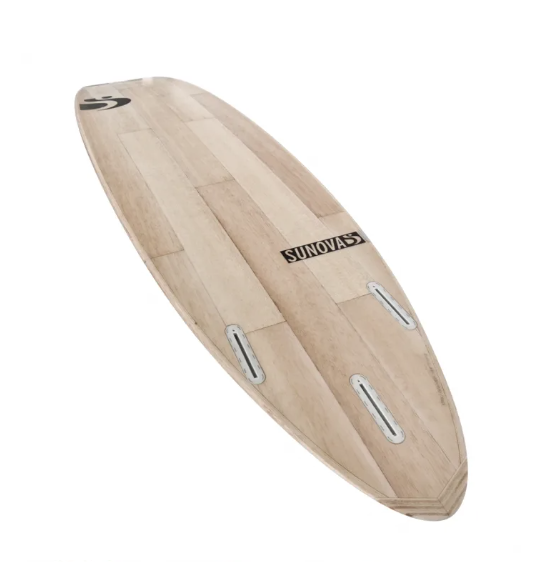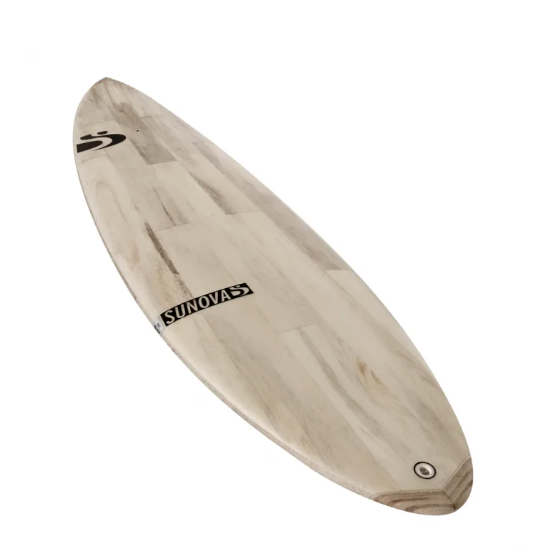Description
8’0 Sunova 8Ball Balsa Flex Standard – Futures – 3 Fin – Black Line
THE 8BALL is a performance mid length board that you can hook turns deep in the pocket, driven by the needs of surfers who want serious paddle power, but still want a board that performs off the tail.
We took some of the characteristics of our long time favorite performance shortboards and we put a longer front end on them. The result is a board that can catch waves like a longboard but surf off the tail like a shortboard. We took the nose entry and flattened it for additional paddle power, then took enough area out of the nose to keep the rails from catching on late drops. As you step onto the tail the curvy outline and performance rocker of the shortboard kick in and you are away, having a ball.
Put the 8Ball in the pocket and see what this board has really got.
| Dimensions | Volume |
| 8’0 x 21 5/8” x 2 11/16” | 50.0 ltr |
- OUTLINE: NARROWER PULLED IN LONGBOARD NOSE, WIDEST POINT PULLED BACK INTO A HIP FLYER, ROUNDED PIN
- BOTTOM: FLAT BOTTOM
- ROCKER: FULL HIGH PERFORMANCE ROCKER
- RAILS: STANDARD PROFILE
- FINS (not included): THRUSTER
- GOAL: A LOOSE, GOOD PADDLING MID LENGTH BOARD THAT CAN HANDLE A RANGE OF CONDITIONS
- WAVE: WAIST HIGH TO DOUBLE OVERHEAD
- RIDER: NOVICE TO PRO
ABOUT THE BOARD
GENERAL GOAL | THEME OF THE BOARD
A loose, good paddling mid-length board that can handle a range of conditions.
WAVE TYPE ||| SIZE IT’S WORKING BEST
All waves, however, it favors juicy waves. From just under waist high up to double overhead and more.
MANEUVERS IT DOES BEST
Back foot snaps and powered-up roundhouse cutbacks.
SKILL LEVEL IT’S BEST FOR
Novice to Pro.
PADDLE POWER
Average.
WHAT YOU THOUGHT OF WHEN YOU DESIGNED IT?
Back in the early 90’s Longboarding made a comeback, so did competitive longboarding. You had 2 distinct schools of longboarder, crew born before the late 1950s who had the chance to grow up longboarding and just had a natural logger style, even if they hadn’t stepped on one for 30 years or more. Then there were crew born in the 60’s, most of whom grew up on shortboards. In an effort to woo more people along to the longboard contests an 8 ft division was created, with the judging criteria based on performance shortboard surfing. This was how the 8 ball came into existence, as a competition 8ft board.
WHAT IT POSSIBLY COMPROMISES ON THEN?
One of the few boards with no compromises, it handles a variety of conditions and comes as close as you get to a true all rounder. If anything then possibly the amount of rocker, it’s more suited to a surfer who keeps his board moving, someone who climbs up like they’re on a horse and says “giddy up boy” may find it doesn’t carry as well as a flatter rocker.
SHAPE DETAILS SUMMARY | DESIGN INFO
OUTLINE
Narrower pulled in longboard nose, widest point pulled back into a hip flyer, rounded pin. The benefit of pulling the widest point back is you get a long nose and a short tail, so the tail resembles a shorter board. When you stand on the tail to turn, it really does feel like you’re on a shorter board. Combined with the hip/flyer it does incredibly tight back foot snaps, gets vertical easily, and hooks under the lip.
RAILS
Standard profile. A lot of boards at this length assume the rider needs extra float and generally come with thicker rails which are harder to bury and have less sensitivity. The 8 Ball’s rails are relatively refined, even more in the tail, so it feels more like the backend of a high-performance shortboard.
ROCKER
Full high performance rocker. With this amount of rocker the board fits nicely into tighter parts of the wave, it prefers being pumped for speed, instead of someone waiting for it to build its own momentum. It also likes a tight cutback at speed along with throw type maneuvers, where you may be going slow, but you can still throw the board up to the lip.
BOTTOM
Flat bottom. The idea is to keep the board going fast, it already has plenty of features to keep the board loose and sensitive, no need for added contours as the overall design is not dependent on bottom contours for control. Additionally the general Sunova construction with the flexible bottom adds another dimension that reduces the need for contours.
DECK
Standard. Not much going on here apart from thickness distribution. Having the nose and tail quite refined reduces swing weight and keeps the tail feeling sensitive and flexy.
FINS (not included)
Thruster. For sure the best performance option, I personally like to run a slightly smaller tail fin, as this frees the tail up a little better in tight under the lip style turns and snaps in general.
FINAL STATEMENT
A high-performance 8ft board that paddles long and surfs short.









